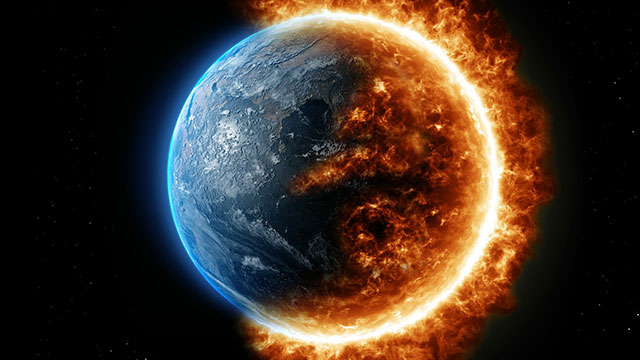Geologists argue natural forces like volcanic activity and ocean currents play a large role in global warming

For interview requests, click here
Could geological factors, often overlooked in climate research, reshape our understanding of global warming? While prevailing models focus on industrialization and fossil fuel emissions as primary drivers, geologists argue that volcanic activity, tectonic shifts, and ocean currents may play a significant role. Incorporating these factors into climate models could challenge the widely held belief that global warming is solely the result of human activity.
This debate comes at a critical time. Recent data reveals that 2023 and 2024 were record-breaking years for global warming. The average temperature in 2023 was 1.45°C higher than the pre-industrial baseline, exceeding expectations and jeopardizing the mid-century 1.5°C goal. Early results for 2024 indicate it is also warmer than anticipated, suggesting the trend is accelerating.
Former NASA scientist Dr. James Hansen and colleagues report that the rate of global warming is increasing. Between 1970 and 2008, the world warmed at a linear rate of approximately 0.18°C per decade. Hansen’s team now estimates this rate has unexpectedly reached between 0.27°C and 0.36°C per decade. This rapid rise has climate scientists and atmospheric models searching for alternative explanations to account for the unprecedented acceleration.
 Geological factors might be reshaping our understanding of global warming. |
| Recommended |
| More oil production in Canada is key to reducing global emissions
|
| Emissions cap is the policy oil giants fear but Canadians need
|
| Was 2023 really the hottest year?
|
To address these gaps, atmospheric scientists may need to collaborate with geologists, who have long studied climate change through glaciation cycles. Geologists acknowledge carbon dioxide as a factor but emphasize other forces, such as volcanic activity, solar cycles, and ocean currents. These elements, particularly ocean currents, play a crucial role by storing solar radiation, redistributing heat and moisture globally, and driving weather systems.
Since carbon dioxide levels are increasing predictably, they are unlikely to explain the sudden acceleration in global warming. One geological line of inquiry focuses on the unexpected appearance of oceanic hotspots worldwide. These hotspots energize oceanic currents like El Niño, which significantly influence global weather patterns and climate variations.
Oceanic hotspots are poorly understood but likely tied to undersea volcanic activity along tectonic plate boundaries—areas where tectonic plates meet and interact. Geologists have noted heightened activity in regions where the Earth’s mantle is closest to the surface, such as Iceland, Hawaii, and Yellowstone National Park. These areas are experiencing notable instability, and volcanic activity appears to be reaching unprecedented levels.
One possible explanation for this surge is a historic polar reversal in the Earth’s magnetic field. Generated by the Earth’s outer core, the magnetic field creates a protective energy shield with twin poles—north and south. Occasionally, the magnetic field “flips,” with 170 polar reversals recorded over the past 100 million years. Although reversals do not happen overnight, the early stages involve a weakening of the magnetic field, which appears to be occurring now.
Measurements dating back to the 19th century, along with data from the European Space Agency, indicate the Earth’s magnetic field has been losing 5 per cent of its strength per decade. Researchers have also observed an acceleration in the movement of the magnetic North Pole, which has increased from 15 kilometres per year to approximately 55 kilometres annually. These changes may be triggering convection currents in the Earth’s mantle—slow-moving flows of molten rock beneath the crust. If so, they could be contributing to increased volcanic activity and the formation of oceanic hotspots.
While speculative, this interplay between geological and atmospheric forces highlights the limitations of current climate models. Geologists’ perspectives on climate change are often overlooked by atmospheric scientists and are rarely included in the Intergovernmental Panel on Climate Change’s research reviews. Incorporating these perspectives could broaden our understanding of global warming and its causes.
This omission raises important questions. Could geological factors challenge the prevailing view that global warming is entirely the result of industrialization? While industrialization and fossil fuels are major contributors, geologists argue that volcanic activity, tectonic shifts, and ocean currents may play a far more significant role than widely acknowledged.
Focusing exclusively on human activity risks oversimplifying a complex issue. By ignoring geological factors, we may be overlooking critical pieces of the climate puzzle. Addressing climate change requires a comprehensive approach that considers all contributing factors—human and natural alike.
The Earth is a dynamic and complex planet shaped by forces both above and below its surface. To tackle global warming effectively, we must develop climate models that account for this complexity. Integrating geological and atmospheric insights can help us better understand the drivers of climate change and adapt to the dynamic future ahead.
This multidisciplinary approach is essential to tackling one of humanity’s most pressing challenges. It demands rigorous inquiry, innovative thinking, and a willingness to challenge assumptions. By incorporating geological factors into climate models, we can move closer to an actionable and accurate understanding of the forces shaping our planet’s future.
Robert McGarvey is an economic historian and former managing director of Merlin Consulting, a London, U.K.-based consulting firm. Robert’s most recent book is Futuromics: A Guide to Thriving in Capitalism’s Third Wave.
Explore more on Environment, Science, Climate change
Troy Media is committed to empowering Canadian community news outlets by providing independent, insightful analysis and commentary. Our mission is to support local media in building an informed and engaged public by delivering reliable content that strengthens community connections, enriches national conversations, and helps Canadians learn from and understand each other better.
